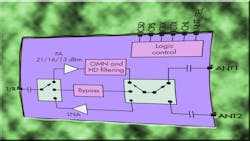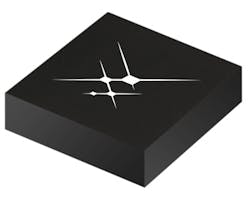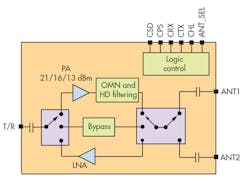Front-End Modules Make Smart Connections for IoT
Download this article in .PDF format
The basic idea of the Internet of Things (IoT) may seem simple: wireless communications between sensors and the Internet. But for engineers faced with designing its component parts, such a simple description is much less than the tip of the iceberg. Challenges are presented by every component within an IoT product, the software that enables it, and the network that coordinates and secures it.
One of the more daunting challenges is the need for unprecedented levels of functional integration to reduce the size, design complexity, and cost of IoT devices. Radio-frequency (RF) front-end modules (FEMs) could very well offer a solution, as they are designed to provide performance and functionality in miniature packages with low power consumption.
Projections for the global acceptance of IoT technology predict billions, even trillions, of these devices operating in many different applications (see figure above), and no single design solution will serve all purposes. In some cases, sensors will remain almost continuously in a sleep mode, coming to life only briefly either when externally instructed, on a schedule programmed into it, or when it detects trouble in the device to which it is connected. In these environments, wireless-enabled sensors should be able to operate for up to 10 years on a coin cell or cells.
In other applications, IoT sensors will be partially or continuously operational, requiring access to mains power or biasing from energy harvesting or wireless power transfer. The multitude of IoT applications may be diverse, but one core requirement remains the same: the need to make every element of an IoT device extremely small, highly integrated, efficient, and frugal with power. Studies project that the cost of IoT devices may have to drop 10 to 100 times and power consumption from milliwatts at present to microwatts or even nanowatts in the future.
Cost-Effective Miniaturization
Integration is the key to achieving serious miniaturization in IoT applications, with the design of RF FEMs including as many functions as possible within a single package. Aided by system-on-chip (SoC) devices that perform analog-to-digital conversion, baseband functions, and overall subsystem control, RF FEMs can deliver a cost-effective solution for IoT applications, with very high performance in a very small footprint. Ever-increasing integration of IoT functions means more functionality will be included in smaller system-in-package (SiP) devices, allowing IoT capabilities to squeeze into even smaller, cost-effective, lower-power solutions (Fig. 1).
Digital circuitry scales smaller in size with advancing technology. For SoCs, the semiconductor technology of choice has been silicon CMOS, with minimum feature sizes shrinking from 250 nm to about 22 nm during the past 25 years, allowing for smaller digital electronic circuitry in IoT solutions. Expectations are that it will drop to about 5 nm by 2025.
RF/microwave circuitry does not scale down in size so easily—the RF/microwave portion of an IoT design can account for 60% of the circuit-board area. While the digital circuitry continues to benefit from reductions in CMOS geometry, the size reduction of RF circuitry can be accomplished by further integration of RF functions on the same die, or by employing advanced packaging technologies.
For IoT applications, integrated RF FEMs offer advantages in smaller size, lower power consumption, and lower cost compared to IoT designs based on discrete devices. The benefits of FEMs over discrete implementations also include reduced design time as a result of components that have been proven and tested together as a single module, compared to mixing and matching separate components. With RF FEMs, the main interconnections are to the SoC. Since RF FEMs are fully tested, turnkey components, they avoid (for the most part) design validation and minimize compliance testing.
Skyworks FEM Ups the Output
Yet another benefit of RF FEMs is compatibility with multiple wireless standards, such as a single RF module for Bluetooth, Thread, and ZigBee wireless connectivity. As an example, the SKY66112-11 RF FEM (Fig. 1) from Skyworks Solutions will serve Bluetooth 5 upon release of that latest version of the short-range wireless standard, as well as next-generation Thread and ZigBee wireless networking protocols. When paired with an SoC platform, the result is an extremely efficient IoT solution with long battery life and extended transmission range by means of high RF output-power levels.
This FEM produces as much as five times the RF output power (+20 dBm) of the SoC radio alone. It eliminates the need for further transmit-side amplification, and can increase receive sensitivity by more than 7 dB to more than double the receive range of an IoT device. It also handles RF input-power levels to +15 dBm to allow the receiver to function in the presence of high-power collocated Wi-Fi access points, which is likely to be a common scenario in many IoT environments. In addition, the SKY66112-11 reduces total system current (Icc) by as much as 38% when compared to an SoC alone delivering the same transmit output power.
The SKY66112-11 provides integrated interstage matching, harmonic filtering, and digital control compatible with CMOS logic levels (Fig. 2). It operates on supply voltages from +1.2 to +3.6 V dc, making it a good fit for battery-powered applications. The FEM is being incorporated in SoC reference designs from all leading SoC suppliers for multimode ZigBee/Thread/BLE systems.
Since the SKY66112-11 will be compatible with Bluetooth 5, its high RF output power will be well-suited to that standard’s enhanced connection range. Bluetooth 5 is expected to be rapidly adopted in new devices beginning in the first half of 2017. Not surprisingly, many of Bluetooth 5’s new features are dedicated to IoT. While Bluetooth is appealing for many IoT applications, it is limited in range, messaging capacity, and networking capability. This latest version should bring the ubiquitous wireless protocol to the forefront of IoT connectivity.
Although complete specifications are expected at year’s end, range should be about 1,000 feet, a best-case value achievable only in unobstructed, line-of-sight conditions, but greater than its predecessor. The range extension makes Bluetooth more than a personal area network for the first time and cost-effective to implement as it requires no infrastructure (access points) and uses far less power.
Bluetooth 5 is also expected to have twice the speed of its predecessor and more than enough speed for almost all IoT applications. The Bluetooth Special Interest Group (SIG) says it will have eight times the data broadcasting bandwidth, which makes the use of Bluetooth beacons far more interesting for retailers and other organizations.
Widespread acceptance of IoT devices and technology will depend on reasonably priced IoT products that can operate for as long as a decade on a battery and communicate over considerable distances in the presence of stronger signals (such as from Wi-Fi systems). While these are not insignificant economic and technological challenges, it should be possible to overcome them thanks to increasing levels of integration and advances in packaging technologies. No doubt RF FEMs will play a significant role.
About the Author
Stefan Fulga
Director of Marketing
Stefan Fulga is Director of Marketing for IoT at Skyworks Solutions Inc.




